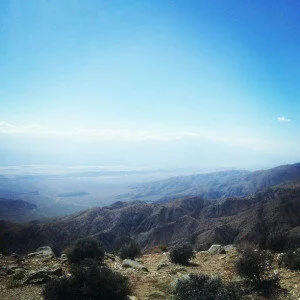Flashback Friday: Joshua Tree National Park
As part of a larger road trip last fall, I visited Joshua Tree National Park for the first time. Joshua Tree NP is located in southern California and spans two ecosystems: the hotter, dryer lower elevation Colorado Desert (which is part of the larger Sonoran Desert), and the cooler and wetter high elevation Mojave Desert. The Mojave Desert is the home of the famous and strange Joshua Trees, from which the park takes its name.
Joshua Tree National Park // tahoefabulous.com
The National Park Service describes Joshua Tree National Park as
“…immense, nearly 800,000 acres, and infinitely variable. It can seem unwelcoming, even brutal during the heat of summer when, in fact, it is delicate and extremely fragile. This is a land shaped by strong winds, sudden torrents of rain, and climatic extremes. Rainfall is sparse and unpredictable. Streambeds are usually dry and waterholes are few. Viewed in summer, this land may appear defeated and dead, but within this parched environment are intricate living systems waiting for the opportune moment to reproduce. The individuals, both plant and animal, that inhabit the park are not individualists. They depend on their entire ecosystem for survival.”
I visited in late September, which meant beautiful weather, sunny but not overly hot. I’d love to check it out in the spring as well, for when it’s a little greener. In addition to the acres of otherworldly Joshua Trees, the park is filled with fascinating desert plants and unbelievable rock formations.
Don’t stab yourself!
During the cooler months, Joshua Tree NP is a rock climbing and bouldering Mecca. Now that I’ve gotten into climbing, I’m excited to return and check it out! The Mountain Project calls it
“a world famous area with thousands of routes, countless boulder problems and a very limited number of campsites. Long popular as a winter destination, it’s appeal has only grown throughout the years as climbers of all abilities have discovered the mild temperatures, grippy rock and surreal landscape which make it a must visit area on any climber’s list.”
Joshua Tree National Park // tahoefabulous.com
While Joshua Tree National Park might seem flat on first glance, this is deceiving. Head up to Keys View for an incredible (but likely hazy) look at the Cochella Valley and the San Andreas Fault.
Joshua Tree National Park // tahoefabulous.com
There is camping available in Joshua Tree NP, though it can fill up quickly during popular times of year. We stayed in the Joshua Tree Inn in city of Joshua Tree, California on the northwest corner of the National Park. The city of Joshua Tree feels like a high desert artist’s paradise, full of funky motels, eclectic restaurants and tons of arts and culture for a city of that size. The Joshua Tree Inn is where rock legend Gram Parsons died, and there is a small shrine to him in the courtyard. Some people come to talk to his ghost, be we certainly didn’t have any ghostly experiences!
Where: Joshua Tree National Park
When to Go: Winter, Fall, and Spring. Avoid Summer!
Where to Stay: Camping at Joshua Tree NP, The Joshua Tree Inn, Joshua Tree, CA
What to Do: Hike some of the many trails, rock climbing, check out the local art in Joshua Tree
What to Eat: The Natural Sisters Cafe, Pie for the People (pizza!), Crossroads Cafe



